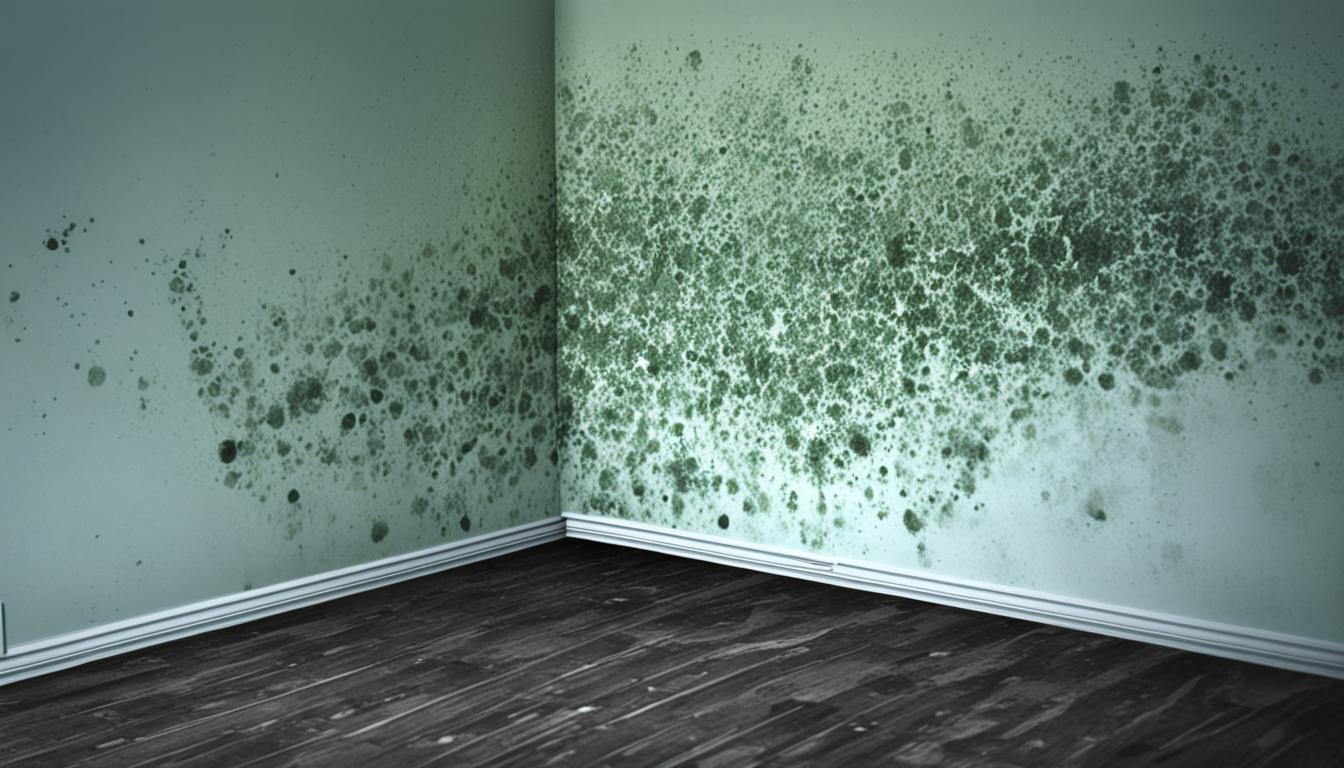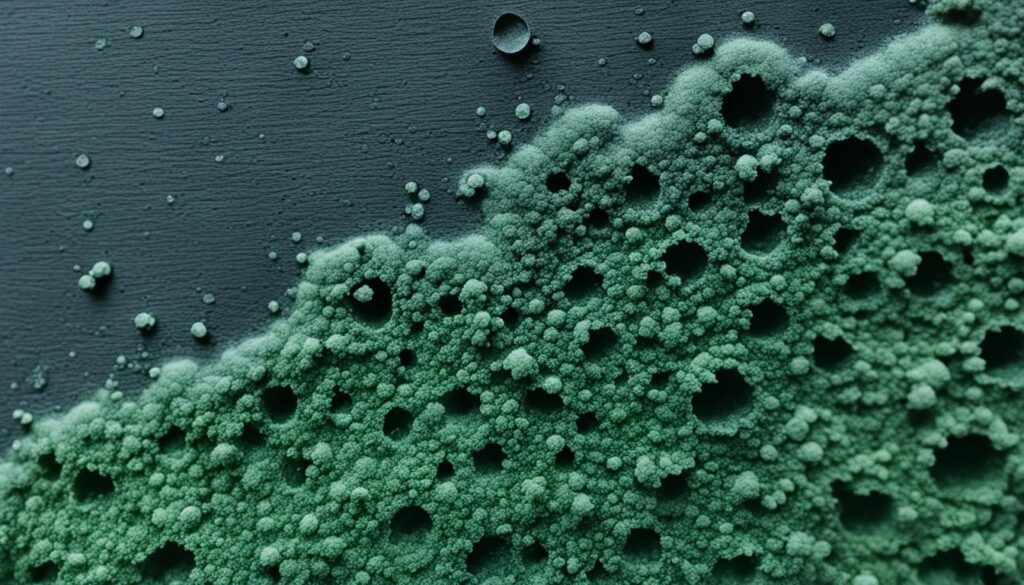
Is Mold Dangerous? Health Risks and Prevention
Mold is a common problem found in many homes and buildings. It can pose various health risks and lead to serious consequences if left untreated. In this section, we will explore the potential dangers of mold and its impact on human health. We will also provide valuable tips on how to prevent mold growth and protect yourself and your loved ones.
Key Takeaways:
- Mold can lead to respiratory issues and allergies.
- Toxic mold can have severe health implications.
- Preventing mold growth requires moisture control and proper ventilation.
- Regular inspections and professional assessments are essential for effective mold management.
- Prompt mold removal is crucial to mitigate health risks.
Understanding Mold and its Health Risks
When it comes to mold, understanding its growth patterns and health risks is crucial for maintaining a safe and healthy living environment. Mold is a type of fungus that thrives in damp and humid conditions, such as poorly ventilated bathrooms or basements.
Mold growth can occur in various environments, both indoor and outdoor. It can be found on surfaces such as walls, ceilings, furniture, and even in the air. The spores released by mold can cause respiratory issues and allergies when inhaled.
The Health Risks of Mold Exposure
Exposure to mold can lead to a range of respiratory issues, particularly for individuals with existing respiratory conditions or weakened immune systems. Inhaling mold spores can trigger asthma attacks, allergic reactions, and other respiratory symptoms, such as coughing, wheezing, and shortness of breath.
In addition to respiratory issues, mold exposure can also cause or exacerbate allergies. Common allergy symptoms associated with mold include sneezing, runny or stuffy nose, itchy or watery eyes, and skin rashes. These symptoms can be especially problematic for individuals with mold allergies or sensitivities.
Furthermore, certain types of mold, known as toxic mold, produce mycotoxins that can pose significant health risks. Exposure to toxic mold can result in more severe symptoms, such as headaches, dizziness, fatigue, and even neurological problems. Individuals with prolonged exposure to toxic mold may experience persistent flu-like symptoms and long-term health complications.
It is important to note that everyone’s sensitivity to mold varies, and some individuals may be more susceptible to its effects than others. However, mold growth should never be ignored or underestimated, as it can lead to serious health consequences.
Preventing Mold Growth
To protect yourself and your family from the health risks associated with mold, it’s essential to take preventive measures to inhibit its growth:
- Keep humidity levels in check, aiming for levels below 50%. Use dehumidifiers, if necessary.
- Regularly inspect and repair any water leaks, damp areas, or condensation issues in your home.
- Ensure proper ventilation in bathrooms, kitchens, and other areas prone to moisture build-up. Use exhaust fans or open windows when cooking or showering.
- Clean and dry any wet or damp surfaces promptly to prevent mold growth.
- Remove any mold-infested materials, such as carpets or wallpaper, and replace them with mold-resistant alternatives.
- Seek professional assistance for thorough mold assessments, especially in cases of severe mold growth or suspicion of toxic mold.
Expert Insights: The Dangers of Mold
“Mold growth in homes can have significant health implications, particularly for individuals with respiratory conditions or compromised immune systems. It is essential to address mold issues promptly and implement preventive measures to minimize the risks. When encountering severe mold growth or potential toxic mold, consulting professionals can help ensure a safe and thorough remediation process.”
– Dr. Rebecca Adams, Environmental Health Specialist
To visually understand the impact of mold growth, here a detailed table showcasing the common types of mold, their preferred environments, and potential health risks:

| Type of Mold | Preferred Environments | Potential Health Risks |
|---|---|---|
| Stachybotrys chartarum (Black Mold) | Damp, water-damaged materials | Serious respiratory issues, neurological problems |
| Aspergillus | Moist, warm environments | Allergic reactions, lung infections |
| Penicillium | Damp areas, water-damaged materials | Allergies, respiratory inflammation |
| Cladosporium | Outdoor environments, moist surfaces | Allergic reactions, respiratory issues |
Prevention and Management of Mold
To ensure a healthy living environment, it is essential to take proactive measures in preventing mold growth in your home. By implementing effective strategies for moisture control, maintaining proper ventilation, and conducting regular inspections, you can significantly reduce the risk of mold infestation.
Moisture Control
Mold thrives in damp and humid conditions, making moisture control a crucial aspect of mold prevention. Here are some tips to keep moisture at bay:
- Fix leaks promptly: Water leaks, whether from pipes, roofs, or windows, must be addressed immediately to prevent moisture buildup.
- Properly ventilate high-moisture areas: Bathrooms, kitchens, and laundry rooms should have adequate ventilation in the form of fans or open windows to reduce moisture accumulation.
- Use dehumidifiers: In humid climates or areas prone to excessive moisture, utilizing dehumidifiers can help maintain optimal humidity levels.
Proper Ventilation
Good ventilation is crucial for controlling humidity levels and promoting air circulation, which discourages mold growth. Consider the following ventilation practices:
- Open windows and doors: Regularly opening windows to allow fresh air in can help prevent moisture buildup.
- Install exhaust fans: Exhaust fans in bathrooms and kitchens help remove moisture-laden air and prevent it from lingering indoors.
- Utilize air purifiers: Air purifiers with HEPA filters can help remove mold spores from the air, improving overall air quality.
Regular Inspections
Performing routine inspections of your home can help you identify and address potential mold issues before they become significant problems. Consider the following inspection practices:
- Check for signs of moisture: Regularly inspect walls, ceilings, and other areas susceptible to water damage for signs of dampness or discoloration.
- Monitor humidity levels: Use a hygrometer to measure humidity levels in different areas of your home and take appropriate action if they exceed recommended levels.
- Seek professional mold assessments: If you suspect or have experienced a mold problem, it is advisable to seek professional mold assessments to accurately identify the extent of the infestation and determine the necessary remediation steps.
Mold Removal
In case of mold infestation, it is crucial to handle the removal process effectively to minimize health risks. Here are some essential steps for effective mold removal:
- Containment: Isolate the affected area to prevent the spread of mold spores to other parts of your home.
- Personal protective equipment: Wear appropriate protective gear, including gloves, goggles, and a mask, to avoid direct contact with mold spores and prevent inhalation.
- Professional remediation: For extensive or toxic mold infestations, it is recommended to engage the services of professional mold remediation experts who have the expertise and equipment to handle the situation safely and efficiently.
- Thorough cleaning: Remove and dispose of any materials contaminated with mold, thoroughly clean all affected surfaces, and ensure complete drying to prevent future growth.
Remember, mold prevention is key to maintaining a healthy and safe living space. By following these preventive measures and seeking professional assistance when necessary, you can effectively manage mold growth and protect yourself and your loved ones from its potential health risks.

| Common Mold Prevention Practices | Effectiveness |
|---|---|
| Proper ventilation | Highly effective in reducing humidity and mold growth |
| Regular inspections and maintenance | Crucial for early identification and prevention |
| Moisture control | Essential to prevent conditions favorable for mold |
| Professional mold assessments | Provides accurate identification and scope of mold infestation |
| Effective mold removal | Ensures thorough elimination of mold and prevents regrowth |
Conclusion
In conclusion, mold can pose significant risks to human health, particularly when left untreated or in the presence of toxic mold. Mold exposure has been linked to various respiratory issues and can trigger allergies in susceptible individuals. Additionally, the presence of toxic mold can lead to more severe health problems.
To protect yourself and your household from the harmful effects of mold, it is essential to understand the potential dangers and take preventive measures. Moisture control and proper ventilation are key in preventing mold growth. Regular inspections can help identify any early signs of mold and prompt action to address the issue.
However, in some cases, professional assistance may be necessary. Mold assessments conducted by trained professionals can help identify the extent of the problem and provide recommendations for effective remediation. Removing mold properly and thoroughly is crucial to ensure the health and safety of your home.
If you are in the Miami area and require top-notch mold assessments, prevention, and remediation services, contact Fix Mold Miami at 305-465-6653. Their team of experts can provide the necessary solutions and guidance to keep your home mold-free and your family healthy.




